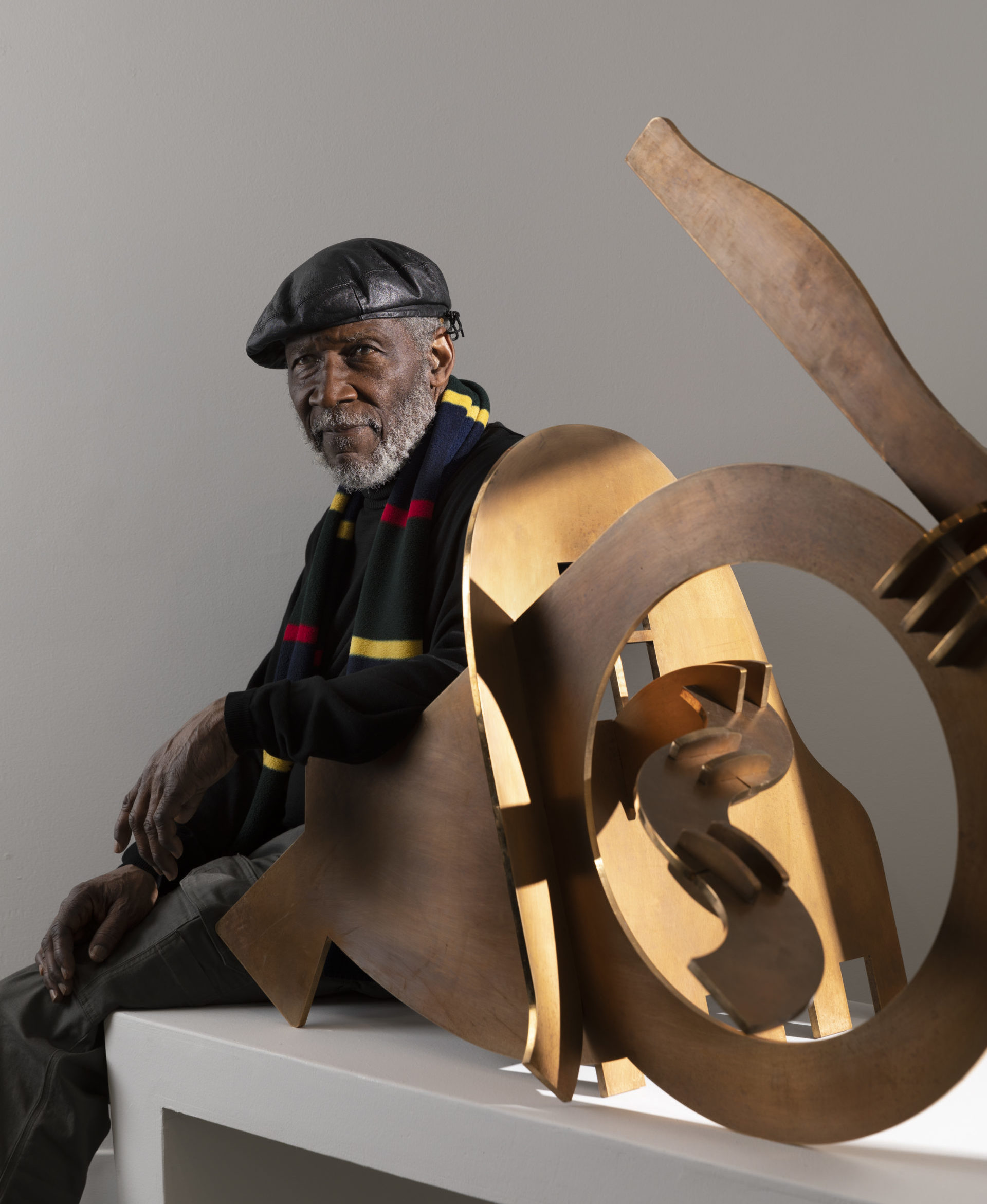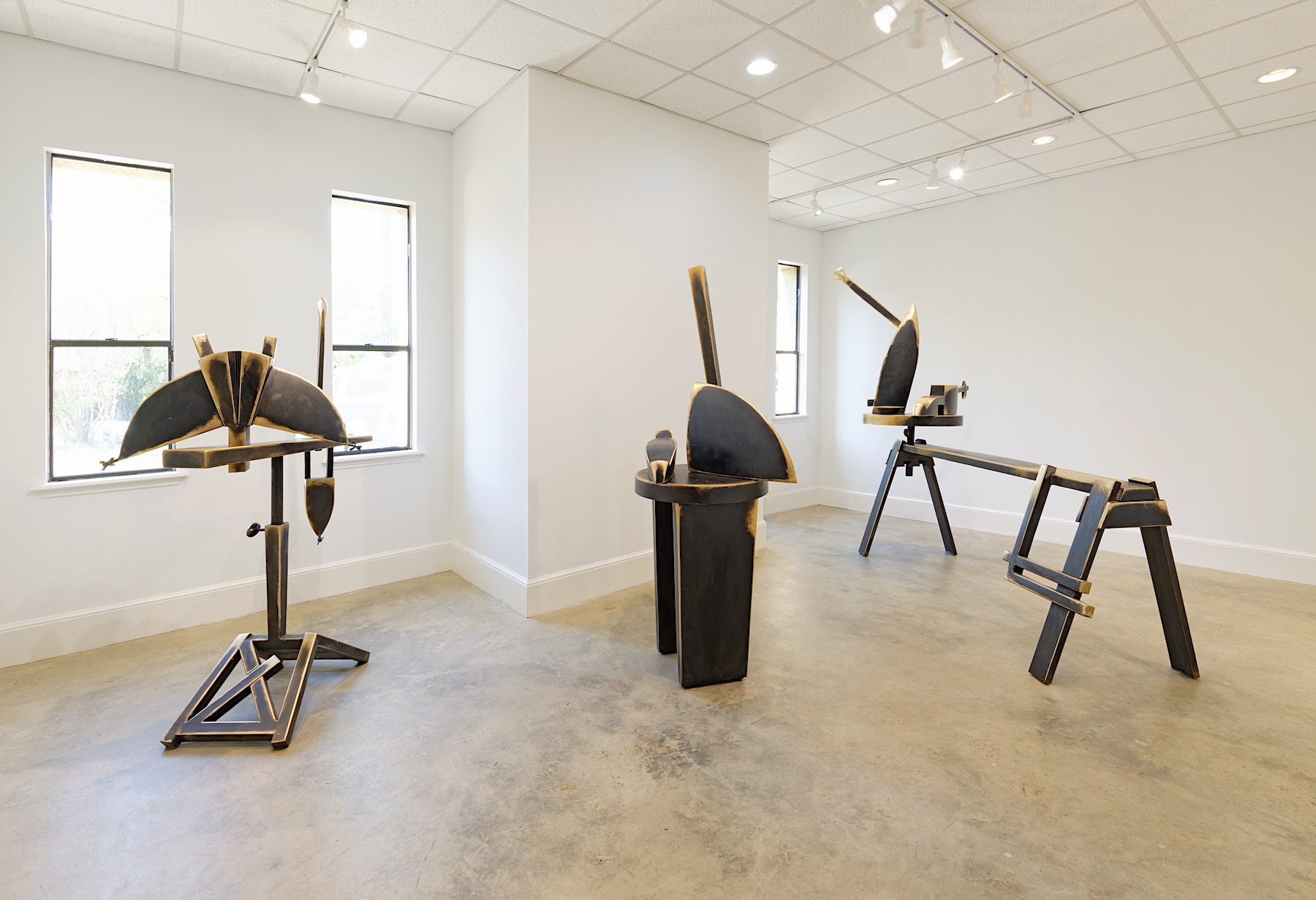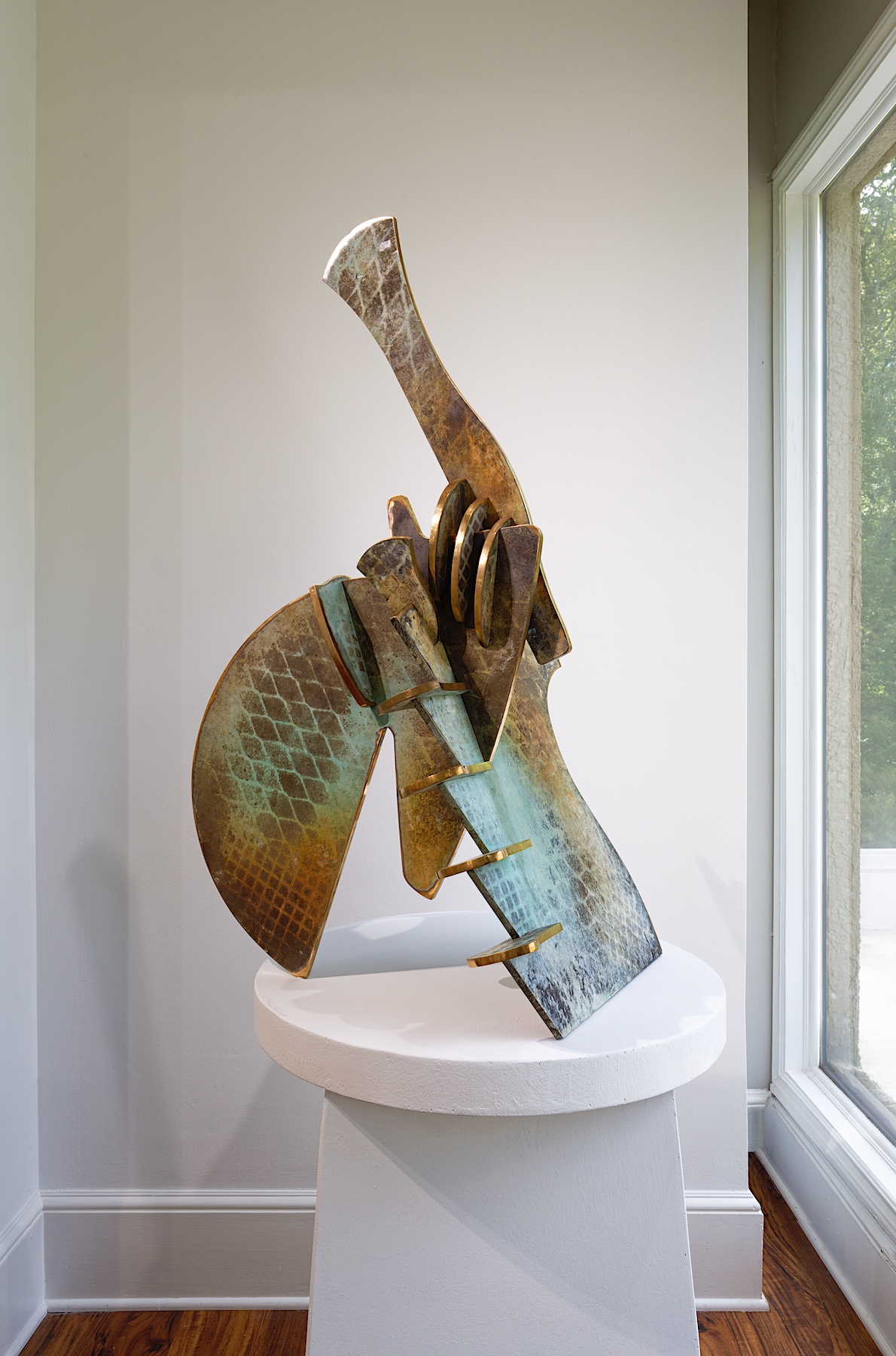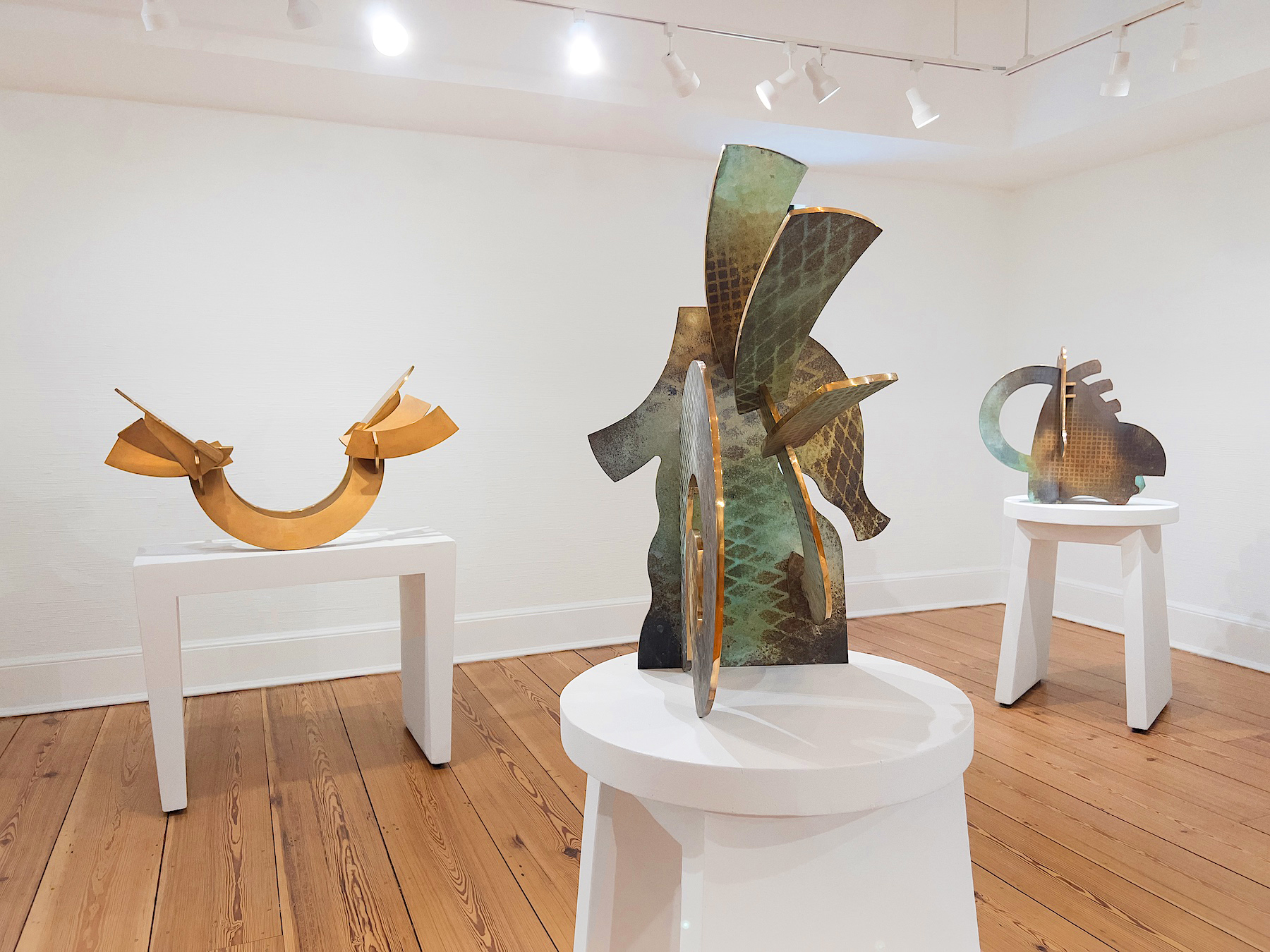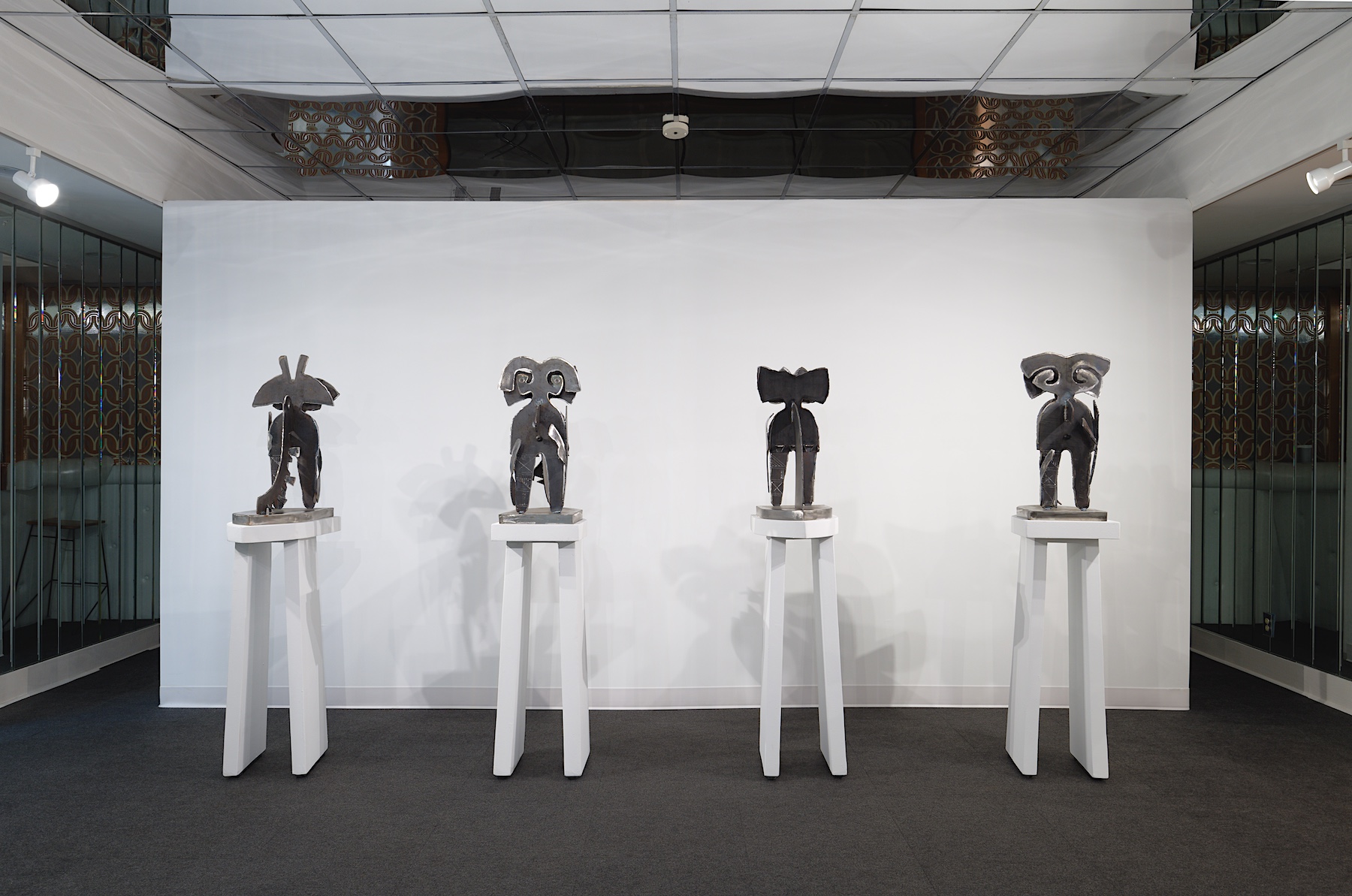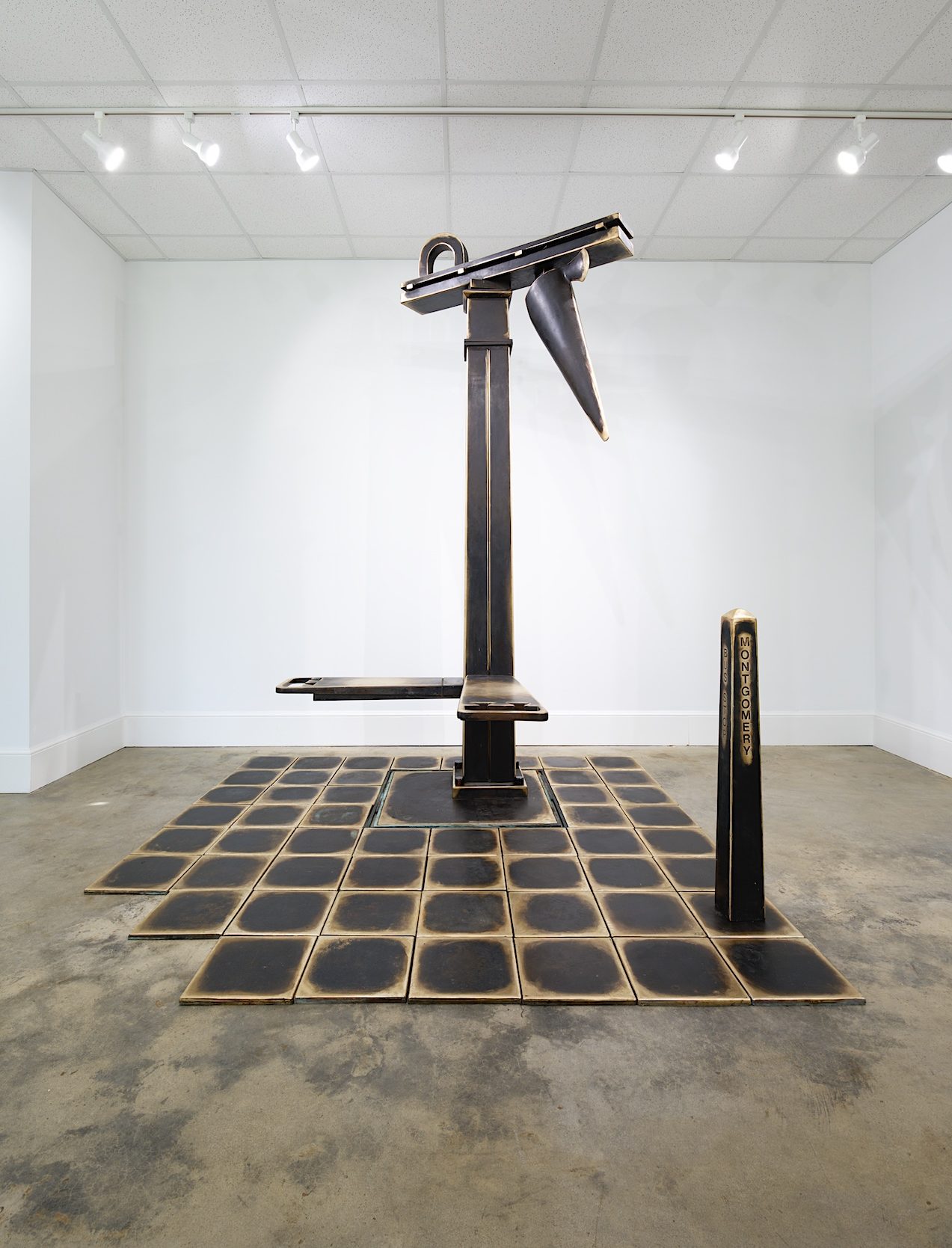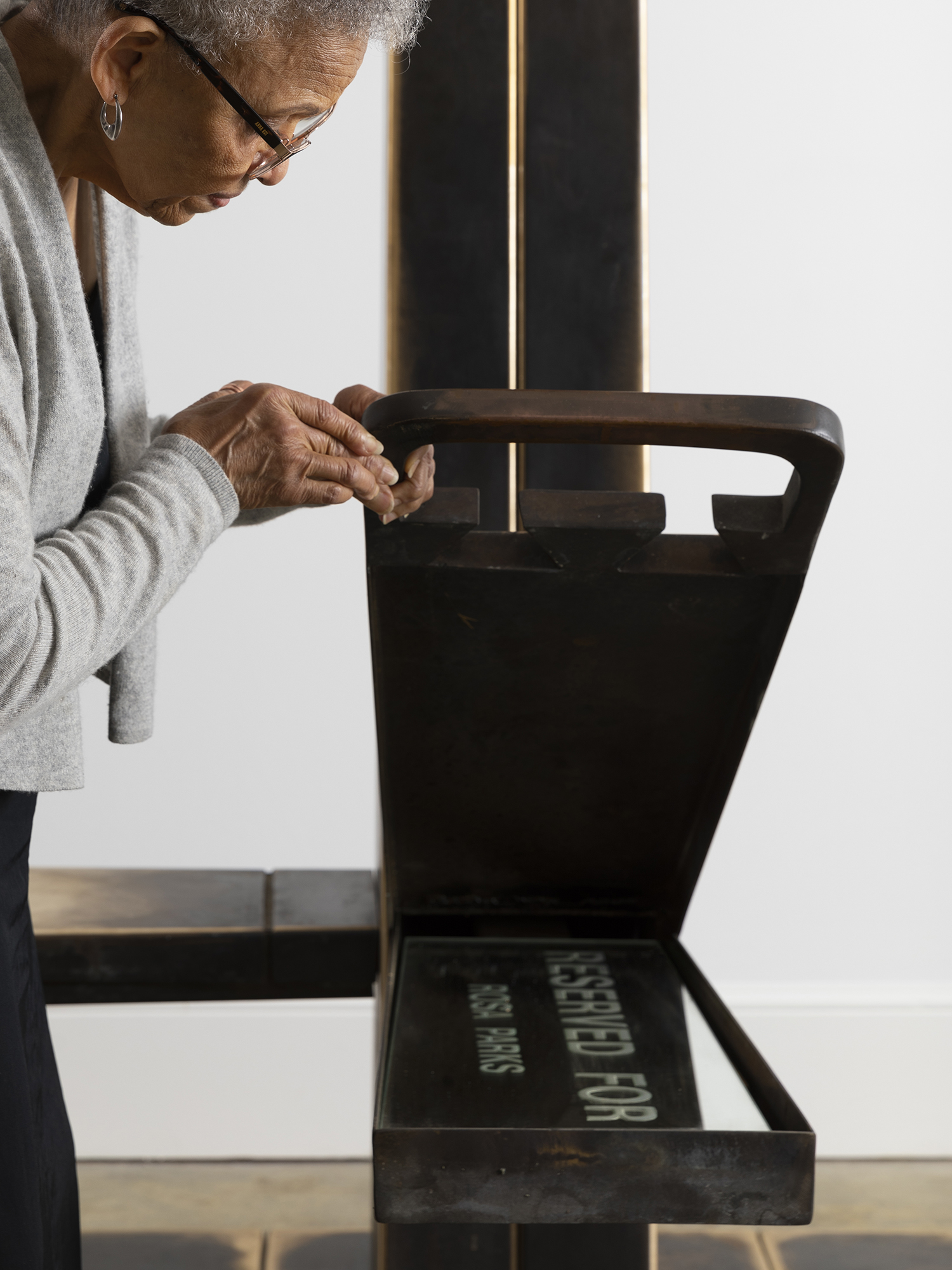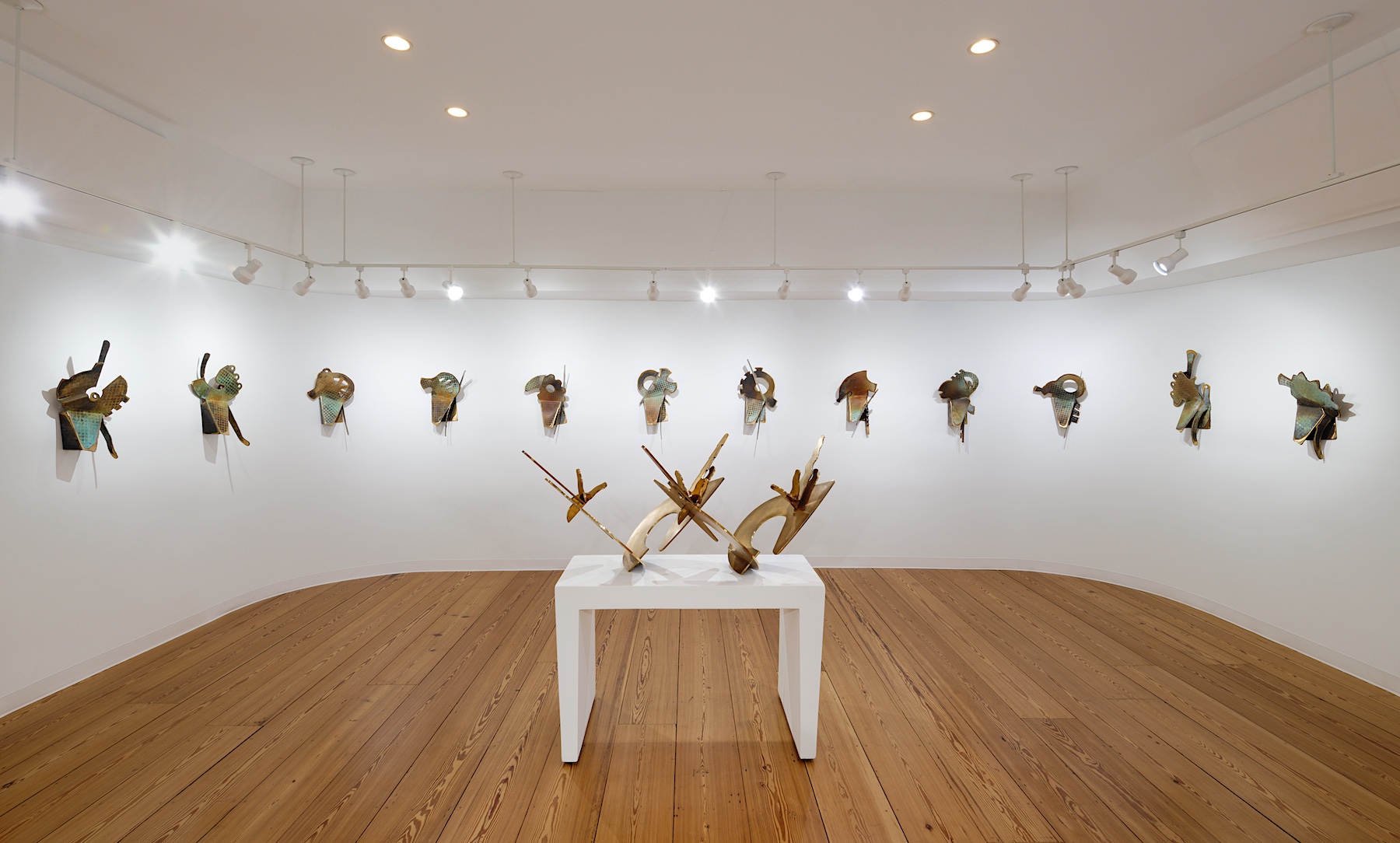
Curtis Patterson, A Notable Journey, installation view, 2022, [photo: David Kaminsky; courtesy of Laney Contemporary, Savannah, GA]
Curtis Patterson: A Monument Maker Gets His Due
Share:
Like many working artists of his generation, 77-year-old sculptor Curtis Patterson spent over 30 years dedicated to teaching. During that time, he influenced many artists, including painters Radcliffe Bailey and Fahamu Pecou, and illustrator Thomas Blackshear. He also pursued an illustrious career in public art, with works installed in Atlanta; Dallas; Shreveport, LA; and St. Paul, MN; among other US cities, often dedicated to Civil Rights leaders. Although many of his public works—such as the iconic Ancestral Notions (2000) formerly installed at Hartsfield-Jackson Atlanta International Airport—are well-known and loved, Patterson has carried on his sculpture practice making numerous bodies of smaller-scaled work in bronze and steel largely unrecognized by the broader art community.
On the occasion of Patterson’s first commercial gallery exhibition—his first solo exhibition since Unbroken Connections in 1993 at Nexus (now Atlanta Contemporary)—we feature this conversation between the artist and Melissa Messina, the show’s curator. They discuss his career as a teaching artist, the “invitational” quality of his public projects, and the symbols of the African diaspora in his work.
Curtis Patterson: A Notable Journey opened at Laney Contemporary in Savannah, GA, on April 1, and will run through May 28, 2022. Patterson’s work will also be the subject of a solo exhibition at the Visual Arts Center of Richmond, VA, in November of this year.
Melissa Messina: I want to start by thanking you. As your former student in the 1990s at the Atlanta College of Art and now curating your first exhibition in Savannah, I just want to say that your guiding hands and the generosity of your spirit makes you the eternal teacher. You and your work have been a continuous source of inspiration in my life, and I know that Sarah Higgins, the Editor and Artistic Director of ART PAPERS, also your former student, feels the same.
Curtis Patterson: I’m grateful that you extended the opportunity to share this time with me, and that’s really one of the wonderful things about teaching. I spent over 30 years teaching, and it’s amazing how things come around. I didn’t think, dealing with you guys back in the ’90s, that I would be having this interview with you at this time….
It’s really been a pleasure, my teaching career …. It meant really long hours, of course, but it also afforded me an opportunity to work in my studio the days that I was off. And that afforded me an opportunity to do some of the commission work that I’ve been able to do.
MM: You haven’t had a lot of gallery exhibitions. Your career took a different turn.
CP: It just happened kind of organically. I taught at the Atlanta College of Art for 30 years, and I taught in the public school system six years prior to that. I was very fortunate to be able to attend graduate school during the time I was working for the Atlanta Public Schools system. So, it took me a little longer to earn my graduate degree. And as soon as I graduated, the job became available at the College, and I was fortunate enough to be hired, so it was really a very smooth transition for me when I look back on it.
MM: And then you began making more large-scale works, which you exhibited in the public sphere?
CP: I got my first commission in 1977, which was awarded by the Bureau of Cultural Affairs here in Atlanta …. My undergraduate work was in painting and drawing, so I really didn’t know very much about sculpture. I attribute a lot of [my skills] to my professor there, George Beasley. We were about the same age, but he was my major professor there, [laughs] and we just had really a wonderful relationship. He was a tremendous influence on my work, particularly from the technical standpoint of how to work with metals.
Curtis Patterson portrait [Photo: Adam Kuehl; courtesy of Laney Contemporary, Savannah, GA]
MM: And you were the first African American student to graduate with a Master’s Degree in Sculpture at Georgia State, is that right?
CP: That’s correct … in 1976. At that time, I didn’t really know any African American sculptors because [they] were not getting much exposure. Shortly after I finished graduate school I had the opportunity of meeting Richard Hunt, Mel Edwards, and Martin Puryear, who are still friends …. But I didn’t know of any African American sculptors at the time that I was in graduate school.
I knew of African American painters, and one in particular was Hale Woodruff. He’s responsible for me being in Atlanta today. My undergraduate work was done at Grambling State University in Louisiana, and my major professor there was Harper T. Phillips, who was a student of Woodruff’s. I heard Harper T. Phillips talk about Hale Woodruff all the time—how much of an influence he was on him and how impactful he had been on his career.
CP (Cont.): Hale Woodruff was responsible for creating an annual [juried] exhibition here in Atlanta. It was called The Atlanta University Annual show [originally the “Exhibition of Paintings, Sculpture, and Prints by Negro Artists in America”]. There were few opportunities for African Americans to exhibit their work in normal venues, so [the Annual] became a really big thing here in Atlanta. As a matter of fact, they have a wonderful collection [at Clark Atlanta University Art Museum] as a result of those shows, and I’m happy to say that I [am] part of that collection.
That’s one of the reasons I ended up in Atlanta, because I wanted to know more about that show, and I can remember distinctly helping my professor, Harper T. Phillips, crate his work to send to those annual exhibitions. So, I really wanted to come over and see what that was all about …. I just fell in love with Atlanta and never really looked back.
MM: We’re so glad that you did. When I think of Richard Hunt, I think of Chicago; and when I think of DC, I think of Martin Puryear; and I think of Melvin Edwards when I think of Houston; but when I think of Atlanta, Curtis, I think of you. You are certainly in that pantheon of artists, and there are a lot of interesting parallels and similarities, particularly in scale and subject matter.
CP: Well, it’s very kind of you to say. I really appreciate that.
MM: I’d love to talk a bit about what inspires your work and how that inspiration informs your materials and your choice of scale. I know, certainly, abstraction plays a big role.
CP: When I first started working three-dimensionally, I worked in clay and became familiar with Henry Moore, who was an abstract artist, and he was definitely an influence on my work. I began working abstractly, and I was familiar with jazz before that. The improvisational approach to jazz is so much like abstraction. It is abstraction, in my opinion. That’s one of the reasons that I gravitate toward working more abstractly. I could work figuratively, but it is a struggle for me to do that. What’s not present is important.
I think any time you look at a piece of sculpture, if it’s not, let’s say, a sphere, which is completely round, the same continuously, regardless of how you look at it— If it’s not a sphere, then there is a sweet spot. There’s going to be one area with more of a preference for the viewer than others. And one of the things that’s been interesting to me is sometimes what I consider my sweet spot is not necessarily the sweet spot for somebody else. What I consider to be the weak spot, somebody will come up and take a photograph of it [laughs], which means that it’s the sweet spot for them. It’s always encouraging to me when I see that. People see things in your work that you just don’t see, and it’s amazing. They have a lot to bring to the work.
MM: You’ve mentioned before that with your public pieces, you want to invite participation, and you want to make work accessible and free from barriers.
CP: I like for my work to be invitational. I like to be able to [physically] enter the work and participate, but I’ve also used walls as barriers … [to represent] racial discrimination. … There’s a piece I did here in Atlanta, A Tribute for Andrew Young (2008), and the central element is an obelisk, which I think is a really beautiful form. One thing that’s interesting about the obelisk is that it’s such a universal object … but there are many people who don’t realize that the obelisk was created on the African continent.
It’s very much a part of my—or our—culture, and it’s wonderful. I think the Washington Monument is one of the most unique. That’s one of the reasons I wanted to use the obelisk for Andrew Young.
But back to the walls: The walls are used in this piece [to represent] barriers of racial discrimination, but … the obelisk rises above the walls, and that’s kind of a victory. I am using the barriers to symbolize the fact that there have been attempts to discredit the advancement of people of African descent. The same thing happens with the piece I did [to honor] Roy Wilkins in St. Paul, Minnesota, which is on the State Capitol grounds there. There are walls in that piece also, and there’s also an obelisk. It’s a very tall element, but at the top of it there’s an African reliquary, symbolic of the work that he did with the civil rights movement. The title of that piece is Spiral for Justice (1995), and it is located adjacent to the state capital so that the obelisk is on axis with the judicial building. So, it’s kind of a visual dialogue between Mr. Wilkins and the judicial process …. I think that’s a profound statement. And you know, it’s abstract, it’s not a figurative representation of him, but it’s a concept, and I think that has merit.
Curtis Patterson, A Notable Journey, installation view, 2022, [photo: David Kaminsky; courtesy of Laney Contemporary]
MM: Absolutely. And so much is being discussed about monuments these days: who is being honored, how they’re honored, who is not honored. As a sculptor who has made many public commissions and monumental works honoring people, could you share your thoughts on monuments? On their history and their future?
CP: There are a number of reasons that I think people should be acknowledged for the contributions they’ve made to our society, but I think one of the important things is that those monuments should be done to help galvanize a community. Unfortunately, many monuments were created with a separatist attitude, and that’s an unfortunate situation. I understand why some monuments were being taken down, because of the blatant separatist attitude that they were created for in the beginning. I think it’s important to still do that. I just think we need to do more to galvanize our community and our society.
MM: When you’re asked to do a commission, you spend a lot of time not only doing research but also talking to community stakeholders.
CP: Doing that allows the stakeholders, people from the community, to feel the sense of worth and participation in the process. I enjoy that. As a matter of fact, for the spiral that I did in Spiral for Justice, in St. Paul, I [made it] go in the reverse direction [from that of my original design]. There’s a main thoroughfare that runs beside the Capitol, and I wanted the obelisk to face the street. [But] one of the people in the community indicated to me that the judicial building was adjacent to the State Capitol. [They said,] “Why don’t we reverse the spiral?” And I thought, wow, I didn’t even know about the judicial building. It made a lot more sense, because Mr. Wilkins was so much involved with the judicial process, that this piece, which represents him, would be on axis with the judicial building. So, by having members of the community and stakeholders participate, it really increases the potential of the piece to be more successful.
Curtis Patterson, Hymn to Freedom, 2019, fabricated bronze, cold patina, 39 x 19 x 22 inches, [photo: David Kaminsky; courtesy of Laney Contemporary, Savannah, GA]
MM: That you were able to modify and reconsider your initial concept with that feedback is quite special.
CP: Also, there are seeing stations [in that work,] and behind each one is a door. You wouldn’t know that—the handle is flush with the wall, but if somebody is so inclined to pull on that handle and open the door, there’s an element of surprise there for them. When you open the door there are quotations by Roy Wilkins, and on one of the doors there’s a portrait of Roy Wilkins. I [collaborated with] one of my former high-school students, Thomas Blackshear, who just [was inducted into the Society of Illustrators’ Hall of Fame]. He did the relief of Roy Wilkins for me. It is a realistic likeness of Mr. Wilkins. In that instance, the people in the community wanted a figurative aspect of Mr. Wilkins, so there’s a portrait of him. Now, if you’re not so inclined to open that door, then you don’t get the surprise, but if you are, then you’re rewarded.
MM: And this concept of movement and notions of what is kinetic finds its way into some of your other, smaller-scale work, which will be a focus in the exhibition, A Notable Journey, at Laney Contemporary. When I think about motion and movement in your work, for example, I think of the Rocker Series (2011–ongoing).
CP: Right, I think I’ve done about twenty pieces now that are considered the Rocker Series. And some of them are kinetic, they do rock, but the others that don’t are based on a tripod with three points that touch the ground. Another approach is to have a blade in point—it’s one plane touching the ground and another point to make the piece stand. The others that rock are equally balanced on both sides so that when they’re not actually rocking they become static, because there is an equal amount of weight on both sides of them, but they do have the potential to rock if you initiate the rock.
MM: And some of them are interlocking.
CP: Right. Very early on I was introduced to slot fitting—I didn’t realize until I went back and looked at some of my work [that] I had been doing this since graduate school. The advantage of working with these slot-fitted pieces was their portability. All of them can be dismantled and all the elements can be placed horizontally in a box or a crate, which makes it very easy for transporting them and for the installation. I see these pieces as my sketches for larger-scale pieces. Hopefully, I’ll get a chance to realize some of them before I leave this good earth, but if I don’t, maybe somebody else will recognize them and maybe want to do that.
Curtis Patterson, A Notable Journey, installation view, 2022, [photo: David Kaminsky; courtesy of Laney Contemporary, Savannah, GA]
MM: And many of your works over the years have referred, sometimes more representationally and sometimes more abstractly, to masks. I think about the series Diasporic Reflections (2021–2022). How do the shapes and symbols that are found in those works connect to some of your other series?
CP: A lot of what you see in Diasporic Reflections, some of those elements and motifs are [also] part of the Rocker Series. I had not done very many relief pieces, and I wanted to do something that would relate to the wall. The first series was a little bit more descriptive—I had things like wing nuts to represent the eyes, and the linear elements to represent the nose, and another wing nut to represent the mouth—and I enjoyed those [aspects] very much. I would make [studies] out of cardboard, and I started just looking at the planes without those elements. A lot of times, less is more. So, I kind of deleted those elements and just went with the elements that are more symbolic of the mask itself, and most of those [also appear in] the Rocker Series.
MM: And can some of those elements also be found in the series Shango’s Friends (2020–ongoing)?
CP: Yeah, some of them can be found in Shango’s Friends. One of the first times I saw Shango was in one of Hale Woodruff’s paintings, who I mentioned earlier I consider to be a big part of my life. It’s the image of the double axe that [I found] such a powerful visual element. I started doing these pieces maybe 12 or 15 years ago—and I [recently] went back and looked at some of them and thought I would revisit them again. Another thing that contributed to [revisiting them] was the pandemic. I have a small studio at my home, and I was working with these cardboard models, and I was able to explore these in cardboard. I didn’t need a welder, or any heavy equipment. I was at home for the last couple years, just planning the Rocker Series and Shango’s Friends, and once I got the plans, I would take them to my studio and fabricate them.
MM: And you often return to Yoruba symbols in your work.
CP: The original Shango was the primary Yoruba element of a double axe. Oftentimes I will use a double iron. I use the iron a lot in my work, primarily as a symbol of domestic labor, which people of African descent have been responsible for implementing over the years. So, it’s a tribute to them.
I’ve used [the form] a lot, even in some of the public work. I did a piece at [Hartsfield-Jackson Atlanta International] airport, that unfortunately has been taken down now because of some of the changes they’ve done architecturally at the airport. One thing about public art: Once it’s in the public domain, it’s no longer under your control. But I had a couple of Shango elements in that piece as well.
Curtis Patterson, A Notable Journey, installation view, 2022, [photo: David Kaminsky; courtesy of Laney Contemporary, Savannah, GA]
MM: I’d be remiss not to ask you about the Unbroken Connections series from the late 1980s. We are going to show a few of those in the Savannah exhibition. They feel very monumental, and yet they have a more human scale.
CP: Yes, Montgomery Bus Stop (1989) was a piece [from that series] in honor of Rosa Parks. When I was growing up, there was a symbol, a small obelisk that was kind of symbolic of the bus stop. You’re probably too young to remember, though, but they were very prominent in the South, and—
MM: —They still have them in Savannah.
CP: Oh, they still have them?
MM: Here and there you can find one, yeah.
CP: I would love to be able to see one. When I did this piece, I really wanted to create kind of an environment. I wanted to create something that would illustrate Rosa Parks’ courage. So, the top element, which is suspended on an obelisk, is symbolic of the Klansman hat, which would create a threatening environment for her. She refused to give up her seat in that threatening environment, which was really saying a lot in terms of courage.
And there’s also another element on the top of the obelisk, which is a fragment of a chain, which represents the continuity of the Civil Rights Movement, and it still goes on today. There are two benches on this piece. One has a poem by Mary McLeod Bethune, which says, “We are the custodians as well as the heirs of a great civilization,” The other bench, which is elevated about four or five inches above Mary McLeod Bethune’s poem, says, “Reserved for Rosa Parks.” And that’s kind of the essence of the piece.
The piece Water for Mandela (1987) was [an early] piece that I did [in that series]; I wanted to do four pieces representing the four elements—earth, air, fire, and water. There’s an offering of water on a table for him, but there’s also a carpenter’s horse, or what we often call a workhorse, which is symbolic of the years that he was incarcerated in a South African prison. And then on top of that table is a [representation of an] outstretched fist, which is my attempt to illustrate, from a figurative standpoint, Mandela. The outstretched fist can be disengaged, and when it is the text on it says, “Amandla,” which means … “power to the people of South Africa,” and there’s another element on it, kind of a shelf that comes out and says, “Water for Mandela,” and then there’s still another element that comes out that says, “Azania,” which is [a] chosen name for South Africa once they reached independence. And that’s basically what the piece is about.
MM: I was recently reading an interview that Mildred Thompson conducted with her professor Lois Mailou Jones in 1991, in an issue of ART PAPERS. I thought to close our own interview it might be a nice nod to her legacy as Associate Editor at the magazine—and a way to honor that both you and she were my professors—that I pose a couple of the questions she posed to Ms. Jones to you, the first one being: Who would you like your audience to be?
CP: Oh, that’s a good question. The world. [laughs] I mean, I’m doing work that emphasizes the African diaspora a lot, but it’s certainly not just for people of African descent. I mean, I would like for everybody to be able to appreciate it. It’s just something that I think is long overdue. It’s pretty incredible how influential African imagery has [been] in contemporary and modern art, but not a lot is said about it. I consider myself kind of a conduit to delineate some of those ideas that are from the African continent. But in terms of viewing it, I would like for everybody to be able to view it. It’s not for one group of people, it’s for people in general.
MM: And lastly: How do you want to be known in history?
CP: I would just like for someone to know that I was trying to recognize the contributions that were made by people of African descent, particularly before me. I stand on their shoulders, and hopefully somebody will come behind me and continue to do the same thing. That’s what I would like to be remembered for, as somebody that’s just trying to raise the consciousness of people who have given so much of themselves.
Curtis Patterson, Montgomery Bus Stop, 1989, fabricated bronze and hot patina, 120 x 120 x 120 inches, [photo: David Kaminsky; courtesy of Laney Contemporary, Savannah, GA]
Curtis Patterson, Montgomery Bus Stop, installation detail, 1989, fabricated bronze and hot patina, 120 x 120 x 120 inches, [photo: David Kaminsky; courtesy of Laney Contemporary, Savannah, GA]
